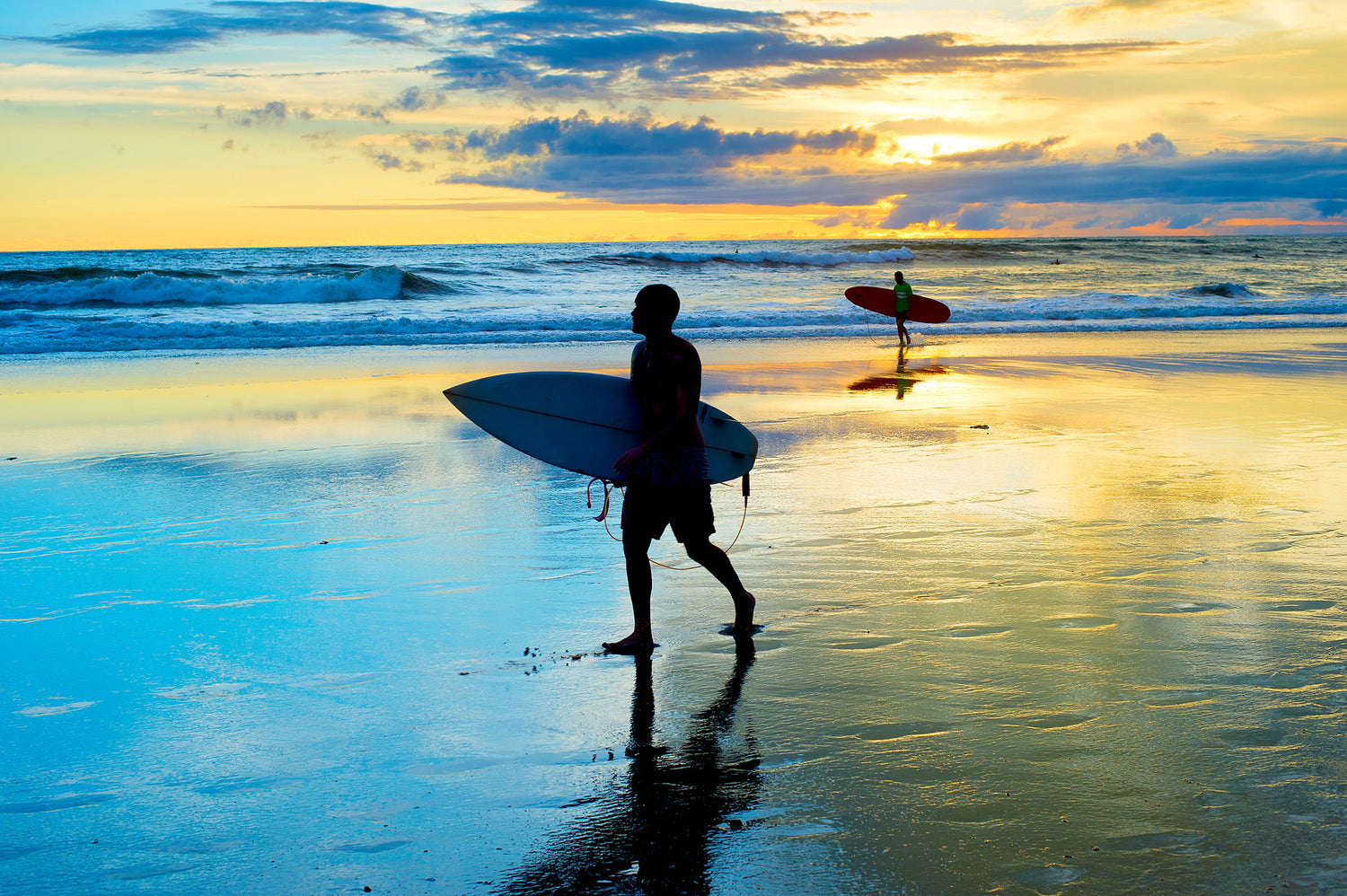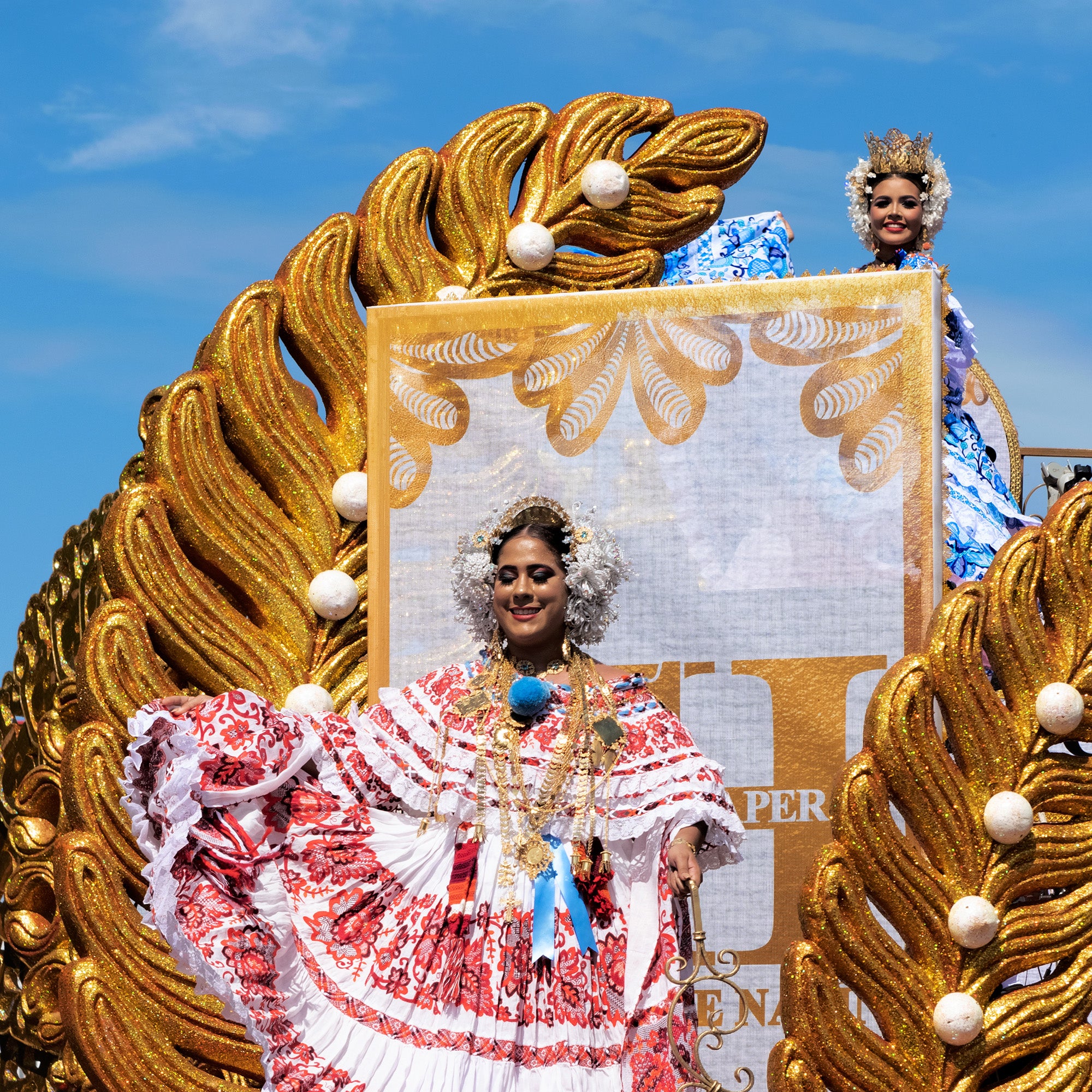Surfing with Jim in Panama Part 1
Seems like every now and then, life forces you to hit the restart button. I had no real itinerary planned for my trip to Panama. Hell, I didn’t even have a surfboard! All I knew that turning 40 only happens just once. My only "plan" was to check-off the grid for a couple weeks. Why surfing and why Panama? Well it's about as far away from the Montana lifestyle you can get!
I'd heard about a great board "shaper" there and figured I'd give him a call. Boa Boards is in Panama City and they were my starting point. Juan Jimenez, the owner, was helpful and he got me booked with local surf legend and guide Kenny Myers. Enjoy part 1 of my Panama Surfing Trip.
Cheers, Jim Markel
PANAMA CITY
My arrival caused some confusion at the airport in Panama City. Guess not many gringos get off the plane from Guatemala. After getting through customs I met Kenny and we headed into the city. Juan was working late shaping some boards so we headed down to the Boa Surf House to check in.
Walking in the front door, the smell of resin and new paint flooded my nostrils. "Cool!" was all I could think as I surveyed the line of new boards in the rack. This kind of reminds me of my own shop, working late on a Friday night.
I was feeling pretty scruffy so I grabbed a quick shower at the shop. Now this is what I call a good retail experience! Clean and refreshed, it was time to get down to some serious shopping.
Like any hobby surfing has it own gear and Boa has everything you could possibly need. Of course, the hardest part's actually selecting the board. Nothing really jumped out at me so we decided on a late dinner.
Heading down to the old quarter we're greeted by 16th century architecture and a relaxed atmosphere. Seems a bit of a renaissance has been taking place. Trendy nightclubs and restaurants abound so we settled at a table outdoors.
We sat beneath the tropical night sky; a million stars above, the cobblestone streets below and the smell of fresh seafood wafting by. I ordered local favorite Pulpo, a side of Brazilian beef and we got to know each other.
GETTING INTO THE CANAL ZONE
The Panama Canal Zone where Kenny lives is a unique neighborhood. Ancon is mixture of colonial architecture; a microcosm inside the bustling metropolis. The homes date from the early 20th century and are made of California redwood. Built originally for the canal workers, they used to be the property of the Canal Zone.
When the Canal was handed back to Panama, the property was privatized. With large yards and gigantic tropical trees, wildlife abounds. The locals are restoring and adding onto these classic colonial style homes.
OLD HOMES, NEW FRIENDS
Besides being a world class surfer, Kenny's also an avid photographer and orchid collector. Exotic plants collected on adventures throughout Panama surround his house. We share in common a love for older homes. My own residence was constructed in 1911 and I've spent most of 14 years restoring and renovating it. Kenny's home, although built in the same era, was completely different. The tropical style without insulation or drywall is quite a departure from homes in the far north.
His front door is made of old-growth redwood at 2 inches thick. A simple masterpiece of nature lovingly restored to its original grandeur. Large windows circle the perimeter. This baby was built before air conditioning so the large overhanging eaves were designed to keep out the tropical sun. Form following function that works with nature.
The long eaves also keep water away from the foundation during the rainy season. They say they don't build 'em like they used to. This is one example that proves it.
BUILDING A CLASSIC SURF BOARD
Up early the next morning and stepping through the door we're greeted like family. Again, I stared in confusion at the wall of boards. OK, time to consult the experts about my skill level and experience (both sadly lacking...). Juan graciously agreed to craft me a board on the spot as the ones in stock were for pros.
Digging through his last stash of Clark foam, he explained this was the end of an era in surfing. The long-time supplier of premium surfboard foam closed its doors. Totally shutting down the last supply of this type of surfboard blank. Watching Juan Jimenez shape a board is truly a privilege. He starts by marking the blank with a pencil, asking my height and weight. He determines the optimal shape by factoring this information.

Jim's Custom Surfboard
Then the foam starts flying! The whine of the planer dominates the small room. I step back to watch the master create. Soon the room is filling with the tiny chips of foam floating on the air, blocking out the light. Like inside an industrial blizzard of light, sound and motion. Methodically he moves over the blank taking it down layer by layer. Time really doesn’t seem to matter as the planer sings its siren song.
Eventually the pace slackens and noise and dust begin to settle. Ears ringing, covered in fine dust, I see the subject of recent fury. Unlike bags at Red Oxx, at a place like Boa, no two boards are exactly the same--that's a good thing. Not so good if you're making bags.
Next, it's time for color. The choices were amazing. Truly something else. Selecting a burnt orange with sunburst was my choice for this classic board.
THE PANAMA CANAL HISTORY
Founded in 1519 Viejo Panama was the first European settlement on the west coast. In 1671 the pirate Sir Henry Morgan sacked Viejo Panama of Spanish treasure. It was the golden age of piracy; a time when governments cut side deals with privateers to further their political agenda.
Piracy still exists today especially in and around places like the Straights of Malacca. Instead of sacking cities for gold and silver they hijack oil tankers and freighters. Standing on top of the old ruins I look out to sea and spy a line of ships waiting to make the crossing.
The Panama Canal is a modern marvel we don't think much about. Construction of the canal took around 30 years and 30,000 lives. Tropical diseases yellow fever and malaria were the chief culprits. The amount of rock and dirt removed was simply staggering.
The canal moves more ships than the designers envisioned. The term Panamax was coined to describe the maximum sized ship that can fit through the locks. We visited the locks at Miraflores and watched as the ships made their way through the canal.
In some cases there's less than two feet on either side of the ship as they're pulled into the lock. Standing on the observation platform as the large container ships are maneuvered through the process your sense of scale is overpowered. The raw power of the engines idling and the pent up energy vibrating from the ships shake the locks as they wait to break loose into the open sea.
A third set of locks is being constructed and this will allow the new larger container ships to pass. This new set of locks is going to be truly massive. The Canal is full of small islands, which are home to several rare and exotic species of frogs and bats. Recently all over Central America amphibian species have been dying out. There's concern the new expansion could further stress this situation.
Kenny's been working with the Panamanian government photographing rare and endangered species like the Golden Frog. Despite conservation and research efforts there's no confirmation on what's causing this alarming trend.
RECOMMENDED TRAVEL ESSENTIALS
I'd accumulated some cargo in Guatemala. Good thing I brought a multitude of bags. Lately I've taken to traveling with a Roadster Mini Ruck tucked into my Sherpa Jr. Expedition Duffel.
For straight "carry-on," I adopt a real minimalist approach. But when I'm checking luggage, it's a completely different scenario.
Transporting donations to the third world is a good use of cargo space you pay for anyway. Having a pack in country is a nice option for day hikes or going to market. They're also a great gift tip for the guide. Having the room to bring home an assortment of native crafts and about 20 lbs of superb Guatemalan coffee is the reward.
I swear, I could live out of my trusty old Tri-Fold Toiletry Kit for at least a month. I keep a second Tri-Fold with my emergency medical supplies from Wilderness Medical Systems.
I know it can be a real pain dragging along a medical kit. But the further you go off-grid, the more you realize it'd be nice to patch yourself together with something clean. They include essential remedies and a nice set of instructions (in case your First Aid's rusty).
I packed my Gator with a Nikon DSLR and Coolpix. Even with both cameras there's still room for a pair of 10x42 Leica Binoculars tucked snugly into a Bino Case.
I stash a Surefire light and spare batteries in the end pocket. It's an FAA requirement flight attendants carry a flashlight. I can imagine a smoke-filled cabin; having a small powerful light close at hand is a small piece of insurance.
PRO TRAVEL TIP: GET SOME INSURANCE
Speaking of insurance? Get some in case you're hurt somewhere. The team at Global Rescue will send people to collect you. They mentioned they had Pararescuemen, known as PJ's.
I needed to hear no more. Each branch of the military has its own special operations assignment.
The Air Force has the PJ's and a PJ's primary function is a personnel recovery specialist, with emergency medical capabilities in humanitarian and combat environments.
PJs deploy in any available manner, to include air-land-sea tactics, into restricted environments to authenticate, extract, treat, stabilize and evacuate injured personnel. Fill out the staff with some SEALS, Green Berets and Force Recon Marines. You get the idea. When people like this come to save your bacon, it gets saved.
SECRET SURFERS
We'd been checking the progress of my surf board and keeping an eye on the swell via the Internet. I had a pretty good idea of what it would look like. I wasn't disappointed. A custom paint scheme. He had a prototype board ready for Kenny to test. We strapped the boards to the Rover's roof and headed to the beach.
Breaking the city's orbit, we head north through a Savannah-like plateau towards Santa Catalina. We rolled along the Pan American Highway. Off in the distance, the mountains of El Copé, the largest nature preserve in Panama. Developing nations are behind the world in establishing national parks and preserves.
Burgeoning populations and a need for raw materials by industrialized nations, countries have been slow to act. There's a real need to conserve what's left. The wants and needs of the many seem to exceed the desire to save.
Before the world was such a crowded place, this was easier to do. Vast tracts of land in the U.S. were set aside by visionary conservationists like Theodore Roosevelt.
Living in a place like Montana, it's easy to take for granted all the wilderness and open land. The more I travel the more I see the wild and untamed places disappearing. Sustainable use combined with natural habitat is essential for continued biodiversity.
SHOWING UP IS HALF THE JOURNEY
Getting out there and supporting these efforts is a lot like life, simply showing up is enough to validate its existence. In this day and age it's all about the money. If tourists show up to see places like the cloud forests of El Copé, parks all over the world will flourish.
Back in the day, Santa Catalina was the most secret surf spot in all of Central America. Kenny was one of the first and few to surf here. Tantalizing pictures were sent to surfing magazines. They never disclosed the location. Monster waves towering triple overhead as they charged the surf during the late 1960’s. Jungle trails cut with a machete gave way to gravel roads. Before you could say "cowabunga," the secret was out.
Next came the surf camps and before long entrepreneurial Italians set up a pizza shack. Surf village Panama was born. There’s still only 1 phone for the village and a 4 hour wait to use it. Being first has its rewards. Kenny’s camp sits right at the point--a straight paddle out to the break.
Kenny warned me Catalina wasn't the place to learn to surf. This break was strictly for experienced surfers. The sheer power and size of this reef-breaking wave is monstrous. Picking my way down to the water I was eager to get out to the break. But first, you have to get to the break.
PADDLING IS HOW TO GET THERE
Paddling is a fundamental building block in the sport of surfing. Pacing myself I settle into a good stroke. Looking ahead I see Kenny efficiently knifing through the water. Taking my time, getting comfortable with my new board.

Ready to do some surfing
Eventually I start making some headway. Finally arriving at the lineup I'm practically exhausted. Feeling content to have a front row seat for some righteous surfing, while sitting up on my board. This is a fundamental skill. While looking easy, it takes balance and core muscle strength. Looking around the pack I spot the experienced surfers loafing on their boards waiting for the next set.
They sit poised in a casual manner. Sun setting to the west I can see the dark outline of an inbound set. Subtly the mood changes in the lineup; surfing is a singular yet competitive sport. Each surfer is gauging the next wave's peak. Catch the wave at the correct point and be the first to drop in.
Kenny gives me the kind of warning that only a seasoned professional is qualified to deal out.
"Stay right here and watch, you don't have any idea how bad you can get hurt here."
By the look on his face I can tell he's not joking. No worries here, I may be crazy but I am not a fool. I watched the sun setting behind a little island. Classic brilliant orange and yellow silhouetted by palm trees and volcanic rock.
To the east the exact opposite, the green palms and saffron colored light lit up the shoreline like an impressionist's painting. The perfect moment in time is always fleeting. Sometimes you go half way around the world to find them. Other times they appear in your own backyard. One thing is for certain: Being able to recognize them is one of the great things about being alive.
The surf is building as the tide is going out. Now I see what Kenny was warning me about, as the rocks begin to appear out of the water. I see him expertly surf around one about the size of a Volkswagen; so close he could reach out and touch it. Yeah, this guy is good and he knows this place like no other. It's time for this rookie to head back in before the sun sets and the big fish come out to eat.
Starting back in seemed pretty straight forward... except one little detail... the tide was going out. Stroking against the tide it was three strokes up and two back! 50 yards from the shore and I wasn't able to lift my arms.
Kenny came cruising by and offered a tow. At that point I was so done. I accepted gratefully. Later over dinner, Kenny explained what I needed for learning was a "beach break." The Estereo was just over the hill. Come morning, a lesson.
THE BEST BEACHES ARE THE CHILDREN'S ONES
Rolling out of the rack close to sunrise a bit stiff, I fired up some oatmeal, fresh sliced papaya and deadly black coffee. Now I was feeling ready for some more sand, sun and surf. We set out for the Estero de Playa. A short walk over the hill from Kenny's camp lies as sweet a beach that I've ever set eyes upon. It takes its name from the fresh water river flowing into it. As the tide changes a small wave is formed and the sea water rushes inland.
Local children come down to play in the warm water at each tide change. I feel the tides power as it carries a dark sand over my feet. I'm watching the kids scamper around a downed palm tree, diving under the rising water in a game of tag.
What strikes me is the lack of people or major development. This is the perfect place for the digital junkie to hide out from the world for a spell. You got to pay your dues if you want to surf and there's no substitute for putting in the time and work on the basic skills. The lesson was quite simple; if you can't paddle you're not going to surf. I had no questions and immediately set about it.
After a couple of hours I still hadn’t caught my first wave; the hammock was calling my name. After a glorious siesta I awoke and made the pilgrimage again. Over the next several days I repeated the pattern until eventually I felt the stiffness leaving my arms. My paddling improved and I made my first wave... And immediately tried to catch another.
Cheers, Jim Markel CEO
Catch the rest of the wave with part 2 of Jim's Panama Trip here.




Leave a comment
This site is protected by hCaptcha and the hCaptcha Privacy Policy and Terms of Service apply.